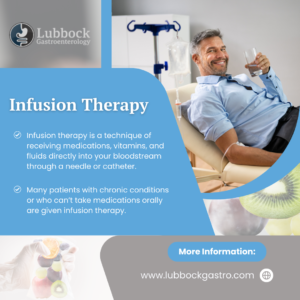Infusion Therapy Lubbock, Tx

Infusion Therapy Lubbock, Tx
Infusion therapy is a technique of receiving medications, vitamins, and fluids directly into your bloodstream through a needle or catheter.
Infusion therapy has been used for many years to deliver medications to patients with various health conditions.
Many patients with chronic conditions or who can’t take medications orally are given infusion therapy.
Many patients who have visited the hospital for various health concerns have received IV therapy.
Continue reading to learn more about infusion therapy.
Why infusion therapy, and how can it help?
Infusion therapy is the most effective way of receiving medications. Medications taken via infusion are better absorbed into the body than oral medications.
This is because medications received via infusion bypass the digestive system and go straight into your bloodstream. The medications are maximally absorbed by the body and immediately used.
When medications are taken orally, they pass through the long journey of the digestive system before getting to the stomach where it is finally absorbed by the body.
The medications would have lost some of their effectiveness as they pass through the digestive system before getting to the stomach. Hence, the body can’t enjoy the maximum benefits of the medications taken orally.
IV therapy is usually administered to patients with chronic or severe health conditions, severe nutritional deficiency, and severe dehydration.
It is also administered to patients who can’t receive oral medications or when there are no comparable or better oral medications.
Infusion therapy is a better alternative to oral medications. It can help in various ways. It can be used to deliver vitamins, nutrition, fluids, as well as various types of medications directly into the bloodstream. The body makes maximum and quick use of medications received via infusion.
With IV therapy, patients experience quicker improvements as the medications go directly into the bloodstream for quick effects.
What conditions can infusion therapy treat?

What conditions can infusion therapy treat
Infusion therapy can treat a wide variety of chronic health conditions including severe infections, chronic headaches, neuropathy, dehydration, autoimmune diseases, gastrointestinal diseases, Crohn’s disease. ulcerative colitis, immune deficiencies, rheumatoid arthritis, etc.
Infusion therapy can also be used to deliver a wide range of medications and nutrition into the body. These include:
- Vitamins and minerals
- Antibiotics
- Antivirals
- Antifungals
- Antiemetics
- Biologics
- Blood factors
- Chemotherapy
- Corticosteroids
- Growth hormones
- Immunoglobulin replacement
- Immunotherapy
- Platelet-rich plasma
- Inotropic heart medications
How to Prepare and What to Expect
Infusion therapy doesn’t require any special preparations. Infusion therapy can be administered in a clinical setting, such as a hospital, clinic, doctor’s office, outpatient facility, or infusion center.
In some cases, health providers can administer some types of IV therapy to patients in the comfort of their homes.
IV therapy can be administered with a needle or catheter. Each infusion session requires a new needle.
Infusion can be administered intravenously, intramuscularly, or subcutaneously.
During intravenous therapy, a cannula is connected into a vein at the back of your hand or any other part of your arm.
A drip pack that contains medication is connected to the cannula. The medication flows through an IV line into the cannula and then into your vein. The medication flows through your vein directly into your bloodstream.
During intramuscular IV therapy, medication is delivered deep into the muscles. A catheter with a needle is used to inject medication into the muscles.
During subcutaneous therapy, a catheter with a needle is used to inject medication into the fatty tissue just under the layer of the skin.
Infusion therapy requires careful administering and monitoring. Intravenous therapy is usually used to administer medications for a longer period of time. You may need to lie down in a hospital bed or sit in a chair while receiving intravenous therapy.
Types of Infusion Therapy and Their Uses
There are different types of infusion therapy. These include:
Intravenous Infusion Therapy
Intravenous infusion therapy involves the delivery of medications into the bloodstream through a vein. A needle or catheter is used to send medications directly into your bloodstream through your vein.
A cannula is inserted into a vein in your hand or arm through which medications flow into your bloodstream. The cannula allows safe doses of medication to be administered into your bloodstream via the same vein without the need for multiple injections.
1. Uses of Intravenous Infusion Therapy
- Intravenous therapy makes the effect of medications in the body quicker. Some people with severe or emergency health problems need to receive medication very quickly. Taking oral medication may not be fast enough as it takes time for the medication to pass through the digestive system before being absorbed and used by the body. Intravenous therapy allows medication to be delivered directly into the bloodstream. The body quickly absorbs the medication and makes use of it.
- Intravenous therapy is often used to deliver medications in a controlled manner. Medications may need to be given in a slow but constant manner. With IV therapy, medications can be administered in a controlled manner.
- It makes medications more effective. When medication is taken through the mouth, it passes through the digestive system before getting to the stomach where it is absorbed by the body. The medication loses some of its potency as it goes through the digestive system. The body can only absorb about 50% of the medication taken orally. This prevents the medication from working very well.
On the other hand, medications taken intravenously are maximally absorbed by the body. The medication goes straight into the bloodstream where it is quickly absorbed by the body. The body is able to absorb 90-100% of the medication administered intravenously, making the medication very effective.
2. Intramuscular Infusion Therapy
Intramuscular infusion therapy is a technique whereby a syringe with a needle is used to deliver medication deep into the muscles.
The body is able to absorb the medication quickly.
Intramuscular injections can be given into the muscles in the arm, shoulder, buttocks, thighs, hips, or stomach.
Just like intravenous infusion, the body can absorb up to 100% of the medication.
Uses of Intramuscular Infusion Therapy
- Intramuscular injections may be used as an alternative to intravenous injections in cases where medication is irritating to the veins or when a suitable vein cannot be located.
- Intramuscular injections may be used instead of oral medications as they’re more effective than oral medications.
- Intramuscular injections may be used as alternatives to subcutaneous injections as medications administered intramuscularly are absorbed faster than medications administered subcutaneously. Also, muscle tissue can hold a larger volume of medication than subcutaneous tissue.
3. Subcutaneous Infusion Therapy
Subcutaneous infusion therapy is a technique whereby a medication is injected into the tissue layer just under the skin.
A syringe with a short needle is used to inject a medication into the tissue layer just underneath the skin.
Medication given subcutaneously is usually absorbed more slowly than medication given intravenously.
Uses of Subcutaneous Infusion Therapy
- Subcutaneous infusion is used when other methods of administering medications might be less effective.
- Subcutaneous infusion may be used as an alternative to intravenous or intramuscular infusion if it is more effective or cheaper.
- Subcutaneous infusion may be a safer and more convenient method of delivery for small amounts of delicate medications. Medications that are given in small volumes, usually less than 1 mL, are given subcutaneously.
Benefits of Infusion Therapy
- IV therapy can be used to safely administer medications directly into the body to quickly improve the health conditions of patients.
- It can be used to administer fluids into the body to help quickly improve severe dehydration.
- It can be used to administer pain relief medications to relieve chronic pain.
- It can be used to administer vitamins and minerals into the bloodstream to address nutritional deficiencies.
- It can be used to boost the immune system by delivering nutrients into the bloodstream.
FAQ
How long does infusion therapy take?
Intramuscular and subcutaneous infusion therapies take less than a minute. Intravenous infusion therapy can take 30 minutes up to 2 hours or more depending on the type of medication being administered.
Is chemotherapy and infusion therapy the same?
Chemotherapy is a type of cancer treatment. Many types of chemotherapy are given as an infusion therapy. With IV therapy, chemotherapy medications can be delivered directly into your bloodstream.
Is infusion better than injection?
Injections are given with a syringe. A medication is placed in a syringe and injected intramuscularly or subcutaneously.
Infusions are given with a cannula. The cannula is inserted into a vein where the medication flows through slowly into the bloodstream.
Infusion is usually used to deliver medications slowly for a long period of time while injection is used to deliver medication quickly. An injection can be given in less than a minute while infusion can take hours to be administered.
How is an infusion done?
During an infusion session, a cannula will be inserted into a vein, usually at the back of the hand. An IV line will be connected to the cannula.
An IV pack that contains the medication will be connected to the IV line and placed on a stand. The medication slowly flows through the cannula into the vein, and finally into the bloodstream.
Can you eat before infusion therapy?
Yes. You can eat before therapy. Most doctors will recommend that you eat first before having therapy.
How do you feel after infusion therapy?
How you will feel after therapy depends on the medication you have. You may feel headaches, a little pain at the injection site, or tiredness.
What should I expect at my first infusion?
It is during your first infusion that a needle will be used to create a channel in your vein before the cannula is inserted. You can expect to feel some level of pain during this process.
You can also expect to feel nervous. You can expect to feel better once the infusion is set and the medication starts flowing into your bloodstream.
What are 3 common signs of an infusion reaction?
The 3 common signs of infusion reaction are;
- Redness of the skin
- Itching
- Skin rashes
Lubbock Gastroenterology: Best Infusion Center in Lubbock, Texas

Lubbock Gastroenterology Best Infusion Center in Lubbock, Texas
You should get infusion therapy from an experienced provider. If you don’t seek an experienced provider, you will likely experience serious complications.
For this reason, we recommend that you get your infusion therapy at Lubbock Gastroenterology.
Lubbock Gastroenterology is a leading infusion Center in Lubbock, Texas. We have experienced medical professionals who administer infusion therapy most effectively and painlessly. We ensure that you feel comfortable throughout your infusion therapy session.
Contact us today or Book an Appointment to get infusion therapy at Lubbock Gastroenterology.
